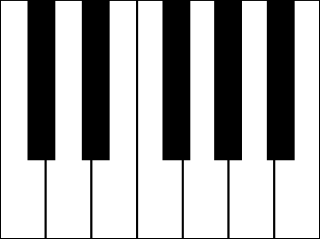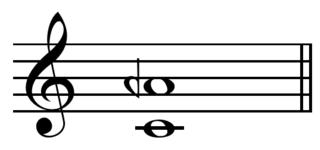
An equal temperament is a musical temperament or tuning system that approximates just intervals by dividing an octave into equal steps. This means the ratio of the frequencies of any adjacent pair of notes is the same, which gives an equal perceived step size, as pitch is perceived roughly as the logarithm of frequency.
In music theory, a scale is any set of musical notes ordered by fundamental frequency or pitch. A scale ordered by increasing pitch is an ascending scale, and a scale ordered by decreasing pitch is a descending scale.

Meantone temperament is a musical temperament, that is a tuning system, obtained by narrowing the fifths so that their ratio is slightly less than 3:2, in order to push the thirds closer to pure. Meantone temperaments are constructed the same way as Pythagorean tuning, as a stack of equal fifths, but it is a temperament in that the fifths are not pure.

The chromatic scale is a set of twelve pitches used in tonal music, with notes separated by the interval of a semitone. Chromatic instruments, such as the piano, are made to produce the chromatic scale, while other instruments capable of continuously variable pitch, such as the trombone and violin, can also produce microtones, or notes between those available on a piano.
In music theory, a tetrachord is a series of four notes separated by three intervals. In traditional music theory, a tetrachord always spanned the interval of a perfect fourth, a 4:3 frequency proportion —but in modern use it means any four-note segment of a scale or tone row, not necessarily related to a particular tuning system.
Articles related to music include:

A quarter tone is a pitch halfway between the usual notes of a chromatic scale or an interval about half as wide as a semitone, which itself is half a whole tone. Quarter tones divide the octave by 50 cents each, and have 24 different pitches.
In the musical system of ancient Greece, genus is a term used to describe certain classes of intonations of the two movable notes within a tetrachord. The tetrachordal system was inherited by the Latin medieval theory of scales and by the modal theory of Byzantine music; it may have been one source of the later theory of the jins of Arabic music. In addition, Aristoxenus calls some patterns of rhythm "genera".
The Turkish makam is a system of melody types used in Turkish classical music and Turkish folk music. It provides a complex set of rules for composing and performance. Each makam specifies a unique intervalic structure and melodic development (seyir). Whether a fixed composition or a spontaneous composition, all attempt to follow the melody type. The rhythmic counterpart of makam in Turkish music is usul.

In music, 53 equal temperament, called 53 TET, 53 EDO, or 53 ET, is the tempered scale derived by dividing the octave into 53 equal steps. Play (help·info) Each step represents a frequency ratio of 21⁄53, or 22.6415 cents, an interval sometimes called the Holdrian comma.

In music, 31 equal temperament, 31-ET, which can also be abbreviated 31-TET or 31-EDO, also known as tricesimoprimal, is the tempered scale derived by dividing the octave into 31 equal-sized steps. Play (help·info) Each step represents a frequency ratio of 31√2, or 38.71 cents.

In music, 19 Tone Equal Temperament, called 19 TET, 19 EDO, 19-ED2 or 19 ET, is the tempered scale derived by dividing the octave into 19 equal steps. Each step represents a frequency ratio of 19√2, or 63.16 cents.

Music theory analyzes the pitch, timing, and structure of music. It uses mathematics to study elements of music such as tempo, chord progression, form, and meter. The attempt to structure and communicate new ways of composing and hearing music has led to musical applications of set theory, abstract algebra and number theory.

A neutral third is a musical interval wider than a minor third play (help·info) but narrower than a major third play (help·info), named by Jan Pieter Land in 1880. Land makes reference to the neutral third attributed to Zalzal, described by Al-Farabi as corresponding to a ratio of 27:22 and by Avicenna as 39:32. The Zalzalian third may have been a mobile interval.
In traditional Arabic music, maqam is the system of melodic modes, which is mainly melodic. The word maqam in Arabic means place, location or position. The Arabic maqam is a melody type. It is "a technique of improvisation" that defines the pitches, patterns, and development of a piece of music and is "unique to Arabian art music". There are 72 heptatonic tone rows or scales of maqamat. These are constructed from augmented, major, neutral, and minor seconds. Each maqam is built on a scale, and carries a tradition that defines its habitual phrases, important notes, melodic development and modulation. Both compositions and improvisations in traditional Arabic music are based on the maqam system. Maqamat can be realized with either vocal or instrumental music, and do not include a rhythmic component.

Mikhail Mishaqa or Michael Mishaka, also known as Doctor Mishaqa, was born in Rashmayyā, Lebanon, and is reputed to be "the first historian of modern Ottoman Syria" as well as the "virtual founder of the twenty-four equal quarter tone scale". Mishaqa's memoir of the 1860 Mount Lebanon civil war is valuable to historians, as it is the only account written by a survivor of the massacre of Syrian Christians in Damascus, Syria. In 1859 he was appointed vice-consul of the United States in Damascus.

A jins in traditional Arabic music theory, is a set of three, four, or five stepwise pitches used to build an Arabic maqam, or melodic mode. They correspond to the English terms trichord, tetrachord, and pentachord. A maqam is made up of two or more ajnas.

A neutral sixth is a musical interval wider than a minor sixth play (help·info) but narrower than a major sixth play (help·info). Three distinct intervals may be termed neutral sixths:

Bayātī, also known as Bayat and Uşşâk (Ushaq), is the name of a maqam in Arabic, Turkish, and related systems of music. Bayati is similar to a natural minor scale, with the primary exception of a half-flat second degree. The maqam is immensely popular in the Arab world, particularly in the Levant. In secular settings, it is favored in dabke and pop music.

In music theory, a neutral interval is an interval that is neither a major nor minor, but instead in between. For example, in equal temperament, a major third is 400 cents, a minor third is 300 cents, and a neutral third is 350 cents. A neutral interval inverts to a neutral interval. For example, the inverse of a neutral third is a neutral sixth.

 Play (help·info)
Play (help·info)










